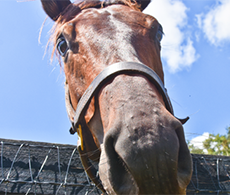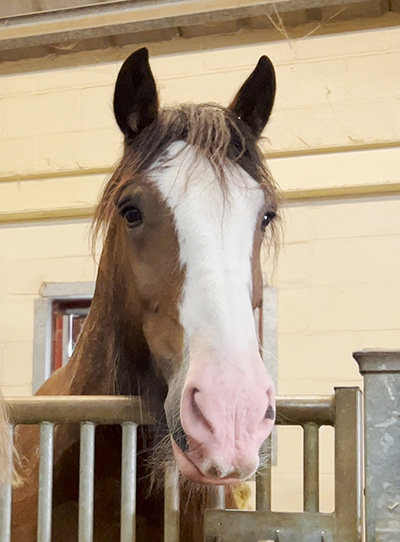
How horses learn
Understanding the ways in which horses learn can help riders to train them in the most effective way, reducing stress and developing a stronger bond.
Wouldn’t it be fantastic if we could train our horses by speaking to them, explaining what we’d like them to do, and for them to respond with their questions or concerns? We might not be able to speak to one another, but we can train horses using ethical methods that tap into their own language, helping to build our bond and make learning fun.
Equine learning theory
Equine behaviourist Justine Harrison, believes that it all begins with understanding how horses learn. The term ‘learning theory’ has been developed by equine behaviourists in response to research into the psychology and behaviour of horses and how they learn.
‘By considering equine learning theory, we can design programmes that enable us to use more ethical methods, teach our horses more effectively and, most importantly, build a better bond,’ says Justine.
There are a number of specific ways in which horses learn, she explains:
Habituation
Probably the simplest form of learning, habituation is where you get used to something over time.
A good example of this is when a horse, who might be nervous of traffic, is turned out in a field next to a busy road. As the days go on, the horse gradually gets used to the sight and sound of the traffic, and soon learns there is nothing to be afraid of.
Always introduce your horse to something new in small steps over a period of time. Gradually increase the intensity and duration until the horse is no longer nervous in any situation.
Operant conditioning
This is where horses learn from the consequences of their actions. It comes in two forms: either reinforcement or punishment.
‘Reinforcement is any event or thing that makes a behaviour more likely to happen again; and punishment is something that makes a behaviour less likely to happen again,’ explains Justine.
Reinforcing or punishing consequences are either classed as positive or negative; positive meaning to add something, and negative meaning to take something away:
Positive reinforcement
When we are positively reinforcing a behaviour, we add something the horse will like, such as a scratch on the withers or treat when asking for a behaviour, which makes a behaviour more likely to happen again.
Once the horse has associated the reward with the action, they are more likely to repeat the behaviour next time.
Negative reinforcement
On the flip side, negative reinforcement is where you remove something unpleasant to encourage the horse to repeat a desired behaviour. For example, when teaching a horse to lead, you might apply pressure to their headcollar to ask them to stop, and once they have stopped, you take away the pressure.
Positive punishment
This is the addition of something unpleasant when a horse exhibits an unwanted behaviour to reduce the chance of it recurring, but too often, horses are punished when they are scared, which could exacerbate the problem. This type of training is often done badly and so should be avoided.
Negative punishment
The opposite to positive punishment, negative punishment is where you remove something rewarding to the horse, which discourages the behaviour. This could be ignoring your horse and withdrawing treats when they are mugging you for food.
Shaping
This is a method of training where the trainer slowly and gradually asks the horse to lengthen or fine-tune a response. An example is teaching a horse to back up – you start by asking for one step, and once they have mastered this, you can then ask for two and then three until they back up constantly with the lightest of aids.
Classical conditioning
Another form of learning is classical conditioning, which is the automatic and unconscious pairing of an event or stimulus with a reflex action or emotion. It was identified by Russian physiologist Ivan Pavlov who, during research on gastric function in dogs, noticed that the dogs started salivating when they saw the assistant that brought them their food.
How the Blue Cross uses learning theory to rehabilitate horses
Grace Shayler is Horse Welfare Supervisor Training at equine charity The Blue Cross. She uses learning theory to underpin how the horse and ponies at the centre are retrained.
‘Many of our horses haven’t come from a particularly nice background and already have a lot of fear, so we use the knowledge of learning theory to shape what we do,’ says Grace. ‘We use operant conditioning, so mainly positive and negative reinforcement, because many have quite negative associations already, especially with humans. We use a lot of positive reinforcement, rewarding them for their good behaviour, and ignore the undesirable behaviours.
‘One example where positive and negative reinforcement has really helped us is with Clydesdale x cob gelding William. He came to us early this year and was referred by the vets because he had a leg issue, which his owner couldn’t treat. While he was at the vet, his owner decided she didn’t want him back. He hadn’t seen the farrier in three years because he was terrified, and his owner had never picked out his back feet, so we had a lot of work to do to change the way he felt about it.

‘We started with him being OK with us touching him. We also spent time working out what he finds rewarding and we used a combination of food and scratching, which also has the effect of lowering the heart rate. We gave him rules around food and he was only given food with a clicker to prevent mugging behaviour.
‘I began by teaching him pressure and release and that standing still made me go away quicker, so I touched the top of his forearm and if he stayed still, I would remove my hand and give a click and treat.
‘Within a month we got to a point where we could pick out his feet. Then we introduced farrier tools to him including a rasp and stand. We taught him to target them, so we’d present him with the tools and when he touched it, he’d get a click and treat. We stayed at that stage for quite a while until he associated the rasp with something nice happening.
‘Then we moved onto him touching it and then me touching his foot with it. He learnt that if he touched the rasp, he was consenting to me touching his foot with the rasp and then he would get his reward. He also learnt that if he didn’t touch it, I wouldn’t touch his feet and I had to listen to that and groom him for a while before trying again. He learnt that he had the choice to participate or not, and after that, he progressed really quickly.
‘Once he learnt that he could say no, he was nearly always happy to engage and let us touch his foot with the rasp.
‘We then went through the same process when introducing the farrier. We still give him the option to engage, and the farrier gives him lots of breaks, so we’re never forcing him to do it. He’s now a much happier, more confident horse and much more relaxed and accepting of the farrier.’
For more information about the Blue Cross, visit www.bluecross.org.uk
Do you use learning theory when training your horse? If so, head to our Facebook page and let us know!



